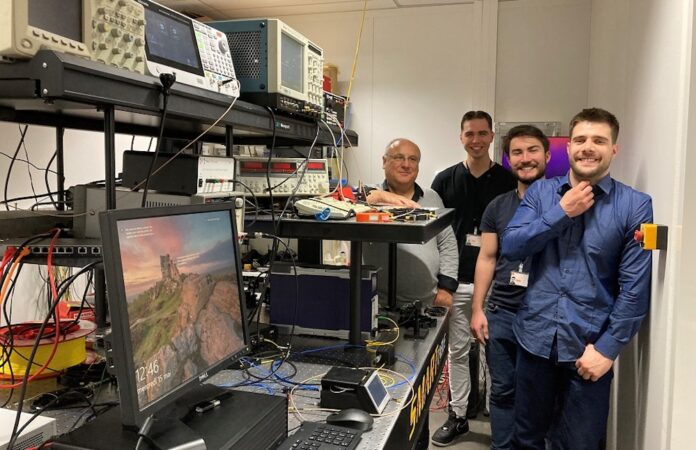The trial paves the way for secure quantum communications based on existing fibre network infrastructure
The ParisRegion Quantum Communication Infrastructure (QCI) consortium, led by Orange has successfully implemented its first quantum communication network in existing fibre optic infrastructure. The trial underlined how the consortium’s hybrid approach is meaningful for future large-scale multi-user networks, to provide an ultra-secure connection for governmental institutions and companies that need to manage sensitive data.
The ParisRegionQCI project, a consortium of industrialists, university researchers and start-ups set out to demonstrate the feasibility of quantum key distribution (QKD) based on existing terrestrial fibre networks. One of the biggest deployment issues is the sheer cost of a large-scale implementation so it was important for the partners to prove it can be done on existing fibre networks.
Equipment related to quantum communications is expensive. “To secure a link of less than 100km on a dedicated fibre, it takes approximately €180 to €250k just for a QKD system and the financial equation quickly becomes insoluble,” said Orange researcher and doctor in optics and photonics Thomas Rivera in a blog post.
“As part of the project, we took the gamble of banking on existing installations. We started with classic fibres already deployed by Orange France, some active and others dark, waiting to be awakened when customer needs require it.”
The partners carried out measurements of optical losses by sending packets of photons into the fibre and characterising their round trips. Then they deployed a quantum communication system, developed by ID Quantique (IDQ) in the field, defined a “seamless” network architecture, added a service layer and implemented an encryption system that Thales adapted so that it accepted these new keys.
Quantum Key Distribution (QKD) was implemented on the infrastructure backbone with relays secured by post-quantum cryptography (PQC) to cover an extended distance range in Orange’s fibre optic network. The installed solution combines IDQ’s commercial Cerberis XG QKD system with embedded Clarion KX software suite (Key Management System), CryptoNext’s Quantum Safe Library (C-QSL) and classical symmetric cryptography.
PQC is the next generation of public key cryptography designed to be resistant to quantum computer attacks. In this setup, QKD provides unbreakable key exchange between remote encryption systems, while PQC guarantees relays security in large scale QKD network deployment.
Results of the trial
The project was finalised in 2023 and the quantum fibre network that the partners built has a range of around 80km. It interconnects several quantum nodes which are represented by the project partners, from the Saclay plateau (Thales, Institut d’Optique, Télécom Paris) to the LIP6 Sorbonne Université laboratory in the center of Paris, via the Orange Gardens site in Châtillon.
What ParisRegionQCI demonstrates is that quantum communication – for the application of a QKD technology here – using or reusing already deployed commercial fibre infrastructures is possible, and this is a major step forward for the launch of a QKD service in France.
“The project also illustrates the dynamism of research in the field of quantum and the synergy of different ecosystems,” said Rivera. “Our consortium brought together large groups (Orange, Thales, Nokia), quantum references in the academic world such as LIP6 led by Eleni Diamanti, the LTCI of Télécom Paris represented by Romain Alléaume and the Institut d’Optique by Phillipe Grangier, as well as start-ups, whose expertise and solutions have been valuable – Quellela, VeriQloud, KETS Quantum and CryptoNext.”
FranceQCI consortium
He added that the infrastructure is intended to be sustainable and to be part of a broader framework than the region. Through the initiative EuroQCI, the member states of the European Union are engaged in the design and construction of national quantum communications networks. “Orange is piloting the work at the French level with the FranceQCI project, launched in 2023: the experimental network that we have set up will be a component and has already expanded by 14km in this context to connect the CNRS (Materials and Materials laboratory),” he said.
“Furthermore, it is also partly reused by the ENS (Kastler Brossel Laboratory), LIP6 and the Parisian start-up Welinq in the form of a quantum LAN, in order to experiment with quantum memory concepts, an essential component of quantum communications of the future,” he added.
The FranceQCI consortium brings together actors with diverse and complementary expertise and resources. As a leading academic institution, University Côte d’Azur is one of the partners of the project, alongside Airbus, CNRS, Cryptonext Security, the Directorate General of Civil Aviation, Orange, Sorbonne University, Télécom Paris, Thales, Thales Alenia Space, Veriqloud and Welinq.
Existing infrastructures in the Paris region (ParisRegionQCI) and Nice (Quantum@UCA/Nice) were used to evolve towards operational quantum key distribution (QKD) services. A quantum network was also set for Toulouse (in the DGAC/DSNA/DTI laboratory) to perform a realistic end-user service test for the French Directorate General of Civil Aviation.
Orange’s use of co-propagation
Rivera said that when it comes to implementing QKD technologies, an alternative and complementary approach to that adopted as part of the ParisRegionQCI project coexists, based on a common goal: using network infrastructures already deployed rather than dedicated fibres.
“Co-propagation, explored by Orange Research teams in Lannion, aims to use a single fibre to carry both the quantum signal dedicated to the key and the ‘classical’ signal associated with the message data (i.e. the WDM data stream),” he said. “The quantum channel can thus be added to existing infrastructures, at a different wavelength from the WDM channels already deployed, avoiding excessively heavy investments (in addition to those linked to QKD equipment).”



